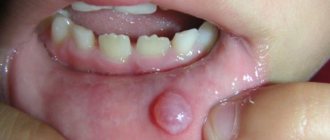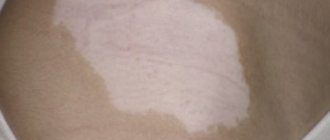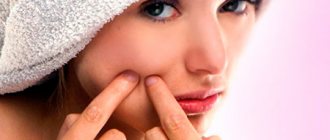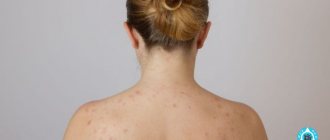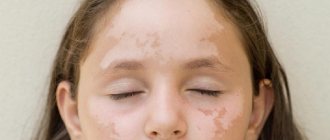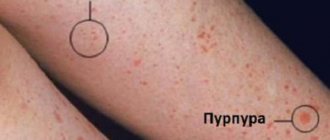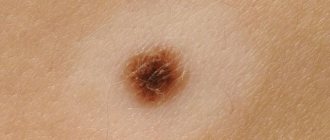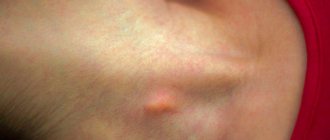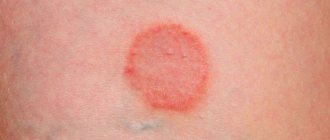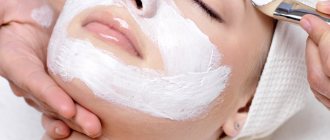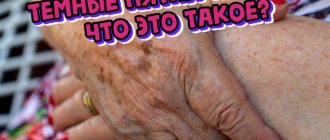H1 CC
Skip to content
- cosmetologist
- Contacts
Home » Facial care » Face masks
Most often, women experience complexes about their face, because it is considered a calling card. And these complexes concern not so much the shape of the eyes or the thickness of the eyebrows, but rashes on the skin.
One of the most significant problems for many women is facial skin like an orange peel. Why does this problem appear and what can be done at home to get rid of it?
What is facial seborrheic dermatitis?
Seborrheic dermatitis, depending on its form and symptoms, is also called eczema. With seborrheic dermatitis, the skin looks like a crust. In addition to the face, the inflammatory process can spread to the scalp, as well as the back and chest.
Seborrheic dermatitis on the neck
The reason for the risk of expanding the area of skin lesions is that these areas of the body are supplied with a large amount of sebaceous glands. Seborrhea may even appear as skin crusts on the eyelids. With seborrheic dermatitis, the skin looks like a crust.
Causes
There are many reasons that can lead to the formation of crusts as the face is prone to many problems such as acne and other skin conditions. These can range from simple injuries to serious skin conditions or dangerous hidden health conditions.
Pimples or acne
Acne, also known as acne vulgaris, is a skin condition where sebum produced by the sebaceous glands blocks the hair follicles. This problem is very common during puberty, when there are intense hormonal changes. Acne usually results in the formation of crusts on damaged skin. Their cause is not precisely determined, but experts believe that the main reason is an increase in the level of the hormone androgen. Acne can cause scabs of skin anywhere on the body, including the face. Types of pimples that can cause crusting include pustules, whiteheads, acne, papules, nodules and cysts. They usually cause sores or lesions that may form scabs during the healing stage. There are many medications that a dermatologist may recommend for treatment, including skin cream as well as other treatments.
Scratches
Conditions that may encourage a person to scratch their facial skin can also trigger this problem. Constant scratching damages skin tissue or even causes bleeding. As the wound begins to heal, scabs may form. Factors or conditions that can lead to chronic scratching include persistent itching from lesions or rashes on the face. They can be caused by infections, dryness, allergic reactions, skin conditions, etc. When the skin on your face is itchy, you can try using mild natural remedies to relieve the itching. The damage can lead to serious infections or very painful sores, and therefore a lot of scabs.
Psoriasis
Psoriasis is a skin condition in which the body's immune system attacks healthy skin cells. According to Webmd.com, in psoriasis, “cells multiply 10 times faster than normal.” The reasons why this occurs are not clear, but some medical experts link it to other autoimmune diseases.
This disease can attack any area of the body, including the scalp, legs, chest, back, face and others. It causes irritation and itching and can be very painful, especially when the skin cracks and bleeds as a result of the lesion. The itchy sensation can lead to damage, which contributes to the formation of scabs. On the other hand, psoriasis lesions also form crusts during the healing process.
Eczema (atopic dermatitis)
Eczema (atopic dermatitis)
This is a common skin condition that often begins before the child is 1 year old and goes away with age in most cases, but not always. The main symptoms of eczema are dryness, redness and itching, and cracks and then crusts may form.
There are many factors that can affect the appearance of eczema, such as dryness, irritants, allergies and infections. It causes many lesions that form scabs as they heal.
Autoimmune disorder
The American Autoimmune Disease Association (AARDA) says these disorders develop when the immune system, which protects the body from disease, decides that healthy cells are foreign and tries to kill them. Depending on the type of autoimmune disorder a person suffers from, it may cause the organ to grow or function unusually. There are many types of these diseases, and many have similar symptoms, making diagnosis difficult. Common autoimmune diseases include rheumatoid arthritis, systemic lupus erythematosus, pernicious anemia, vitiligo, celiac disease, scleroderma, inflammatory bowel disease, Hashimoto's disease and psoriasis.
Again, the exact cause of autoimmune diseases is unknown, but may depend on the following factors:
- Bacteria or viral infections
- Drugs
- Chemical irritants
- Environmental irritants.
They can cause itching or lesions that cause crusting.
Maxillofacial trauma
Injury
This type of injury is defined as any injury to the face, upper jawbone, lower jaw, cheeks, nose, or forehead. Common causes include penetrating wounds, car accidents, violence, and sports injuries or wounds. Symptoms include swelling, bruising, or bleeding. Other consequences may include missing teeth, double vision and deformities. As bruises or wounds heal, scabs form.
Bacterial infections
Impetigo is one of the bacterial infections that causes crusts for a long time.
There is a wide range of bacterial infections that can lead to an itchy rash on the face. They can be caused by different types of bacteria. Irritation from them will cause scratches and, consequently, scarring. They can also cause serious skin damage. Common bacterial infections that contribute to this problem include:
- Folliculitis
- Ritter's disease (scalded skin syndrome) in infants
- Toxic shock syndrome
- Phlegmon
- Erysipelas
- Impetigo is a bacterial infectious disease of the superficial layers of the skin, which occurs most often in children aged 2-6 years or athletes participating in contact sports (infected from each other).
- Scarlet fever.
Dry facial skin
According to Medicinenet.com, “itching is one of the most common symptoms of dry skin.” Dryness is a lack of water in the surface layer of the skin. It can cause severe itching. This skin condition is more common in older people. Dry skin can cause complications such as rashes, eczema and bacterial infections. This can also lead to cracking and destruction, and then the formation of crusts. The condition is always mild, but can be very severe, especially when it comes to bacterial infections. The most effective treatments include corticosteroids, anti-scar lotions and creams. In cases of bacterial infections, antibiotics may be used.
Allergic reactions
This is an abnormal way the body responds to a foreign substance. These can include certain foods, medications, plants, dust, pollen, insect bites and some pets. Allergies have many symptoms, but the most important one in this case is a red, itchy rash that can lead to sores and scabs. The best treatment for this condition is antihistamines.
Causes and factors of facial seborrhea
The main provocateur of seborrheic dermatitis on the face is a fungus of the Pityrosporum ovale type, which is present in every person, only in an inactive form.
Decreased immunity and excess sebum secretion leads to its active reproduction. Therefore, if you discover a seborrheic crust on your face, you should definitely contact a dermatologist to find out and eliminate the causes of its occurrence.
Internal causes of seborrheic dermatosis of the scalp:
- Parkinson's disease;
- Disorders in the functioning of the nervous system;
- Epilepsy;
- Malfunctions of the endocrine system;
- Diseases of the immune system and infectious nature;
- Impaired glucose tolerance of any type;
- Lack of zinc or vitamin PP;
- Genetic predisposition.
External causes of facial dermatitis:
- Hyperhidrosis;
- Improper diet;
- Frequent stressful situations that provoke psychological disorders;
- Hypothermia of the body;
- Chronic lack of sleep;
- Incorrectly selected or low-quality facial skin care products.
Important! One of the most serious causes of seborrheic dermatitis on the face is a tumor of the adrenal glands or malignant formations of the gastrointestinal tract and reproductive system. Therefore, a thorough diagnosis and examination of the body is needed to exclude these factors before starting treatment for crusts on the skin.
Related article:
Seborrheic dermatitis of the scalp - treatment of the disease
Types of seborrheic dermatitis on the face
Seborrheic facial dermatosis is divided into three types:
- Dry dermatitis. Characteristic symptoms are excessive dryness of the skin and the appearance of cracks on it.
Dry dermatitis on the face
- Oily dermatitis. With this form of seborrheic dermatitis, acne, pimples, and a greasy shine on the face occur.
Oily dermatitis on the face
- Mixed seborrhea. Here the symptoms will be complex, characteristic of oily and dry dermatitis.
Mixed seborrhea
Important! The mixed type of seborrheic dermatitis is very similar in symptoms to lichen, psoriasis, and atopic dermatitis. Only a qualified dermatologist can determine the true cause of the disease.
Symptoms
The appearance of facial seborrhea can be recognized by the following signs:
Seborrheic dermatitis
- Irritation, peeling, itching and redness of the facial skin, possibly a burning sensation and tightness;
- The formation of white or yellow scales on the face;
- The skin of the face becomes more sensitive even to a soft touch - this causes pain;
- Formation and accumulation of single or multiple papules on the surface of the skin of the cheekbones, forehead, nasolabial folds and eyebrows.
In the initial stages of seborrheic facial dermatitis, red patches usually form, which then turn into yellowish plaques. The rashes grow and take on different shapes.
As the disease progresses, severe discomfort and itching appears.
Photo of seborrheic dermatitis on the face
Seborrheic dermatitis on the cheek
Seborrheic dermatitis on the nose
Seborrheic dermatitis on the face
Seborrheic dermatitis on the face
Seborrheic dermatitis on the eyelid
Seborrheic dermatitis on the eyelid
Uncommon causes of skin peeling and crusting
- Lichen planus (itchy, scaly papules on the legs)
- Solar keratosis
- Discoid eczema
- Pityriasis versicolor (lichen versicolor) (large scaly patches caused by a fungal infection)
- Guttate psoriasis (scaly papules)
Cracks, blisters, wounds, crusts are symptoms of an eczematous inflammatory process. External signs demonstrate one or another stage of the inflammatory process in its classical manifestation.
But eczematous rashes are characterized by polyformity (variety), so often the patient exhibits all of the above symptoms at the same time. Therefore, when diagnosing a disease, a dermatologist is guided by the number of skin rashes of one type or another.
Seborrheic dermatitis on the face in children
Seborrheic dermatitis on the baby's face
This skin damage is usually observed in the first 2-3 weeks after the birth of the baby.
The signs are most pronounced in the scalp, and on the cheeks, forehead and ears there are fewer or no signs at all. Usually these are dry crusts.
No medications are prescribed for treatment; they are usually limited to the diet of the nursing mother.
Appearance
Dry seborrheic dermatitis on the face is characterized by increased dryness of the skin, the appearance of flaking and small scales that easily peel off from the skin.
As the disease progresses, the patient's face acquires a reddish tint, and light yellow crusts form on the inflamed surface. In some cases, cracks appear.
Lesions can be localized in areas such as:
- forehead and eyebrows;
- nose bridge area;
- lower cheeks;
- nasolabial folds;
- area around the lips.
Important!
Patients with seborrhea also experience a deterioration in the condition of their hair - it becomes dull and brittle.
Treatment of seborrheic facial dermatitis with drugs
The following drugs for seborrheic dermatitis have shown good effectiveness:
- Tsindol
Creams and ointments for seborrhea on the face - “Ketodine”, “Nizoral” and “Clotrimazole”, “Lamisil”, “Tsindol”; - 2-5% Ichthyol paste has antimycotic and keratolytic effects;
- “Prednisolone”, “Hydrocortisone” - these ointments and creams for seborrheic facial dermatitis are prescribed to relieve the inflammatory process and alleviate the patient’s general condition.
- “Ketoconazole”, “Terbinafine”, “Fluconazole” - these tablets are prescribed if the disease is in an advanced form and a large crust is observed in an adult on the face or other parts of the head;
- "Diflucan" - used for recurrent seborrheic scabs on the face or head, the drug has a number of contraindications, accordingly - it is taken exclusively for its intended purpose and under the supervision of specialists;
Diflucan
- “Erius”, “Diazolin”, “Tavegil”, “Claritin” or “Loratadine” - these antihistamine ointments for seborrhea and crusts on the face are prescribed if there are additional symptoms in the form of allergic reactions;
- "Betamethasone" or "Lorinden" - these steroids are prescribed for a particularly acute form of seborrheic dermatitis;
- "Bifiform" and "Linex" - these prebiotics are prescribed for seborrheic dermatitis to normalize the microflora of the gastrointestinal tract.
Important! Immunoregulators “Elidel” or “Protopic” and vitamins B, C, E, D can be prescribed as auxiliary drugs for the complex treatment of seborrhea on the face.
Sensibio
Other drugs for facial seborrhea have also proven themselves well - Sensibio, Bioderma, Sebovalis.
If it is revealed that the cause of the development of seborrheic dermatitis in the form of a crust on the skin is associated with improper functioning of the gastrointestinal tract, medications are additionally prescribed to normalize the intestinal microflora.
The most commonly used are Creon, Hofitol, and Enterosgel.
Duration of treatment
Treatment of dandruff and sores with shampoos may take several weeks , but the first results are noticeable within the first few days of use. If shampoos and conditioners do not help, it is recommended to contact a trichologist who will prescribe treatment.
Treatment of scabs and dandruff involves the use of medications, the use of shampoos and traditional recipes.
Medications:
- esdepalletrin - quickly relieves itching and dandruff, an excellent remedy for fighting mites, which die after the first use;
- Walkinson's ointment - quickly helps with itching, rashes and redness, even eliminates dandruff, due to its high toxicity it is contraindicated for children;
- crotamiton is available in the form of a cream and emulsion, applied after a shower to cleansed skin, contraindicated for children, during pregnancy and lactation;
- spregal – available in the form of a spray, eliminates dandruff sores.
If the reason lies in an unbalanced diet, diet adjustments must be made . The menu includes fruits, vegetables, and multivitamin complexes can also be used. The problem can also be caused by dysfunctions of the digestive system; to eliminate it, a special diet is prescribed.
Seborrhea on the face - features of treatment and skin restoration
Treatment of seborrheic dermatitis on the face has some of its own characteristics:
- When a seborrheic crust forms on the eyelids, rinsing with antiseptics and using antibacterial eye drops are additionally prescribed.
Antibacterial drops Okomistin
- When seborrheic dermatitis affects the cheeks, skin of the eyebrows and other parts of the face, physiotherapy procedures are prescribed. Techniques such as cryotherapy, darsonvalization, and UV irradiation are used.
Treatment of seborrhea on the scalp
If, during the examination of the patient, a scab on the scalp was detected, the following agents must be included in the course of therapy:
- Sulsena shampoo
Shampoos and gels for skin fungus - “Nizoral”, “Sulsena”, “Kelual DS”, “Ketoconazole”, are prescribed in courses of at least 2 weeks; - Antiseptics - products such as tar soap, tea tree essence, and zinc paste have worked well for seborrheic dermatitis on the scalp;
- Ointments and creams for seborrhea - “Zinocap”, “Advantan”, “Skin-Cap”.
The whole essence of therapy for scabs on the skin of the face and head due to seborrheic dermatitis comes down to stopping the inflammatory process, disinfecting fungal-affected areas of the skin, gently and quickly removing keratinized particles, moisturizing it and reducing peeling.
Video about the treatment of seborrheic dermatitis on the face
How long does it take to treat?
With complex treatment, the visual result is visible after 7-10 days. Discomfort (itching and burning) goes away much earlier, after the first procedures (shampoo, ointments).
The full course of treatment with shampoos and ointments averages 20-30 days. Then you must definitely take a break so that you do not get used to certain active components.
If, after following all the recommendations, improvement has not occurred after 5-7 days from the start of treatment, you should definitely consult a doctor for advice. In this case, you may need to change medications and choose other ointments and shampoos.
Dandruff that appears is not as harmless as it might seem at first glance. It is better to immediately pay attention to your health, identify and eliminate the cause of seborrhea, than wait for complications in the form of severe itching, rashes, wounds and sores on the head.
Stress, fatigue, poor nutrition and improper hair care can trigger the appearance of seborrhea. To prevent the situation from becoming more complicated with more severe consequences, you must immediately, when a problem is discovered, seek help from qualified specialists and begin comprehensive treatment.
Treatment of seborrheic dermatitis on the facial skin with folk remedies
Fungal diseases have affected people since ancient civilizations. Therefore, over the centuries, effective folk remedies have been identified in practice that will help get rid of seborrhea on the skin of the face.
Here are some effective recipes that will help alleviate the condition and speed up the healing process:
- Sea buckthorn oil
Ointment from golden mustache gruel - juice in the amount of 2 tablespoons from crushed leaves of the plant is mixed with the same amount of olive oil and half a tablespoon of valerian tincture; - A compress of crushed raw potatoes is applied to the affected areas of the face for an hour or two;
- Sea buckthorn or bay oil in the amount of 1 tablespoon is mixed with a couple of drops of tea tree oil;
- Decoctions of medicinal herbs are used for rubbing several times a day - calendula or sage with a string are most suitable;
- A mask of crushed cucumber and honey - keep it on the face for 15 to 30 minutes, then wash off with warm water.
Diet for seborrheic dermatitis on the face is the key to a quick recovery
When treating seborrhea on the facial skin of an adult, it is very important to establish a proper diet and follow a diet until the end of treatment.
Basic rules of the mode:
- Avoid alcohol, spices, pickles, pickled foods, smoked foods, sweets, baked goods, fast food, fatty, fried foods, as well as citrus fruits and other possible allergens;
- Include legumes, lean veal, pork or chicken meat, cereals, grains, vegetables, fruits, vegetable oil, dairy products in the menu;
- Increase your daily water volume.
Important! When choosing a cooking method, give preference to boiling or steaming.
Prevention of facial dermatosis
Seborrheic dermatitis, especially chronic or very acute form, takes quite a long time to treat - at least 2 weeks.
Therefore, in the future it is better to take some measures to avoid a relapse, especially since they are all simple and contribute to an overall improvement in health:
- Observe the rules of personal hygiene;
- Reduce the amount of alcoholic beverages you drink;
- Monitor your weight and skin condition;
- Avoid overheating, freezing, and sweat running down your skin;
- Regularly undergo preventive examinations with a dermatologist, and women are also recommended to visit a gynecologist once every six months;
- Monitor possible hormonal imbalances, normalize them in a timely manner, based on the doctor’s recommendations;
- Reduce the number of stressful situations or change your attitude towards them;
- Establish the correct daily routine;
- Carry out preventive measures to strengthen the immune system;
- Choose your cosmetics carefully and with bias.
Any fungal diseases are extremely unpleasant and difficult to treat. Therefore, if you have seborrheic dermatitis on your face, be sure to follow the regimen of ointments and other medications prescribed by a specialist so as not to delay treatment and quickly restore the normal condition of your facial skin.
How to get rid of orange peel yourself
To ensure that your efforts to get rid of imperfections are not in vain, you need to resort not only to direct, but also to indirect effects on the skin.
For this:
- Improve your living conditions. Stop not getting enough sleep and not eating enough. Avoid stress and overwork. Monitor your body's health. Play sports whenever possible.
- Don’t be lazy, cleanse your skin of dirt and makeup before going to bed;
- Use gel for washing;
- Do not overdo it with applying cosmetics to your skin. Using face masks too often can also cause negative consequences.
For maximum results, it is not enough to simply follow these recommendations. Along with home remedies, consult a professional cosmetologist. The treatment will not take much time, but will have a great effect on the skin.
